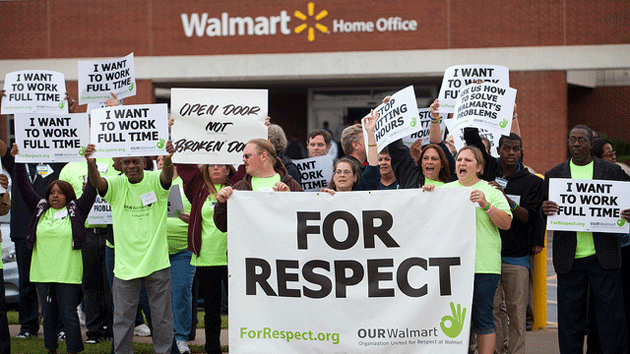
<a href="https://www.flickr.com/photos/ourwalmart/6278199468/in/photolist-ayMpYq-ayJGcz-ayMqd3-ayMqs7-ayJJvD-ayMnFj-ayJJAP-ayMnfm-ayJHkx-ayJHwM-ayJG3K-ayMqmu-ayMpwm-ayJFAH-ayJHgc-ayMmXQ-ayMqoQ-ayJKJD-ayJGGK-ayMrk5-ayJGUc-ayMr51-ayMq6j-ayJHH4-ayMm7u-ayMkK1-ayMo5S-ayJKTe-ayMo99-ayJGSx-ayJH7i-ayMqXS-ayJHqF-ayJLmT-ayMoCS-ayJGVH-ayMpeq-ayMphb-ayMp7L-ayMpku-ayJEUB-ayMq1h-ayJJxn-ayJJcF-ayJJzc-ayJHCv-ayMrd7-ayMqff-ayJJPk-ayMpq5">Our Walmart</a>/Flickr
Black Friday is best known as the day when big-box retailers rake in money, but it has also become a time for some of their employees to demand a share of the proceeds. At Walmart, this year’s Black Friday protests will be the widest-reaching ever, organizers say, with pickets and strikes planned at 1600 stores in 49 states to remind shoppers that the people serving them often can’t afford to feed themselves.
“I have to depend on the government mostly,” says Fatmata Jabbie, a 21-year-old single mother of two who earns $8.40 an hour working at a Walmart in Alexandria, Virginia. She makes ends meet with food stamps, subsidized housing, and Medicaid. “Walmart should pay us $15 an hour and let us work full-time hours,” she says. “That would change our lives. That would change our whole path. I wouldn’t be dependent on government too much. I could buy clothes for my kids to wear.”
The nation’s largest employer, Walmart employs 1.4 million people, or 10 percent of all retail workers, and pulls in $16 billion in annual profits. Its largest stockholders—Christy, Jim, Alice, and S. Robson Walton—are the nation’s wealthiest family, collectively worth $145 billion. Yet the company is notorious for paying poverty wages and using part-time schedules to avoid offering workers benefits. Last year, a report commissioned by Congressional Democrats found that each Walmart store costs taxpayers between 900,000 and $1.75 million per year because so many employees are forced to turn to government aid.
The group behind the Black Friday protests, the union-backed Organization for Respect at Walmart (OUR Walmart) was founded in 2011 to pursue a new approach to improving labor conditions at the retail giant. Rather than try to overcome Walmart’s union-busting tactics, OUR Walmart has focused on publicly shaming the company through a relentless PR campaign and mass demonstrations. Organizers say the approach is working: Since 2012, Walmart has instituted a new pregnancy policy and a scheduling policy that helps workers get more shifts.
Like the holiday retail season, this year’s Walmart protests actually started before Black Friday. On Wednesday, Jabbie walked off her shift along with other workers who are demanding a $15 wage and full-time hours. Other Walmart workers walked off the job in California, Florida, Illinois, Louisiana, Maryland, Massachusetts, Minnesota, Oregon, Pennsylvania, Texas, Virginia, Wisconsin, and Washington, D.C. Here’s what the strike looked like:

“It felt great,” Jabbie told me. “I feel like doing it over and over again until they get the message.”
On Thanksgiving Day, 12 striking Walmart workers and community members began a 24-hour fast to protest wages so low they leave employees hungry.
Today thousands more workers will be at it again—and tweeting under the hashtag #WalmartStrikers. I’ll be posting updates below.
UPDATE 3:06 a.m. EST: A protest is already underway at the Walmart store in Long Beach, California.
It’s a long night people! ##WalmartStrikers pic.twitter.com/Ony9r2Lv7Y
— TR Albert (@bigtalbert13) November 28, 2014
UPDATE 11:03 a.m. EST: Walmart pickets are in full-swing around the country.
#WalmartStrikers protesting #BlackFriday in Chicago pic.twitter.com/d6o6wX3xg2
— Ric (@RicChciuk) November 28, 2014
ForRespect : RT OurWalmartDFW: #WalmartStrikers dallasaflcio ForRespect ChangeWalmart th… http://t.co/LVu9T54CLJ) pic.twitter.com/7vlg7Dnp8h
— SpokaneIWW (@SpokaneIWW) November 28, 2014
Calling on Walmart to respect their workers in Toledo #WalmartStrikers @ChangeWalmart @ForRespect pic.twitter.com/sWiuU7iVXV
— Kate Jacob (@katemjacob) November 28, 2014
UPDATE 11:07 a.m. EST: On a press call with OUR Walmart, Shomari Lewis, a worker for a Walmart store in Dallas, said 100 picketing employees attempted to enter the store but were denied access. “I’m 32 and I am nowhere near where my parents were at this time in their lives,” he said. “I thought getting a job a the nation’s largest employer would be a great way to start a career, but boy, was I wrong.” He makes around $9 an hour and can’t afford a car. “I can’t just go out and buy food during the pay period because I don’t even know how much I’ll have money for… I don’t know how we are supposed to have families or raise them when Walmart is keeping us in poverty.”
“We know that the Waltons can afford to pay us better,” says Ronee Hinton, a Walmart employee who participated in a sit-down strike in Washington, DC, this morning. She gets paid $8.40 an hour for 20 to 30 hours a week, and her schedule arbitrarily shifts “all the time.” This forces her to choose “between going to a doctor’s appointment and missing a shift at work,” she says. “It’s not a choice that I want to make especially now that I am expecting a baby… I don’t know how I will raise a child on Walmart’s pay.”
At a Walmart in Los Angeles, community members and Walmart workers are continuing a 24-hour strike to protest the company’s hunger wages. “The hunger I’m experiencing right now is all too familiar,” says Richard Reynoso, a stocker at the store who hasn’t eaten since yesterday. “Many Walmart workers experience it every day… [but] nobody who works for the richest company in America should ever experience that kind of thing.”
Many of today’s protests have a festive feel. There’s a live band in DC, and a Santa Claus in Denver who will deliver coal to managers.
In Chicago, seven Walmart workers were arrested while blocking traffic on the road on front of the store.
In Washington State, there are protests at 64 stores—every store in the state.
Here are more protest scenes from around the country:
.@johnzangas: #WalmartStrikers nearing #Walmart in NW Wash DC. #BlackFriday protests are in support of #Ferguson pic.twitter.com/rzzvSjFTQ2
— RightWingWatch Fan (@RWwatchMA) November 28, 2014
#walmartstrikers in Vista Ca! #union #BlackFriday pic.twitter.com/eIvVYJpNWG
— Palomarfacfed (@Palomarfacfed) November 28, 2014
The rhythm section from @CTUL_MN keeps us marching briskly! #WalmartStrikers #BlackFridayWOA #EndPovertyWages pic.twitter.com/2k9sompDAg
— Jess Banks (@ProfBanks) November 28, 2014
Stand with #WalmartStrikers for fair wages and hours! http://t.co/7M9nNuCfYM pic.twitter.com/guGeFcAxNo @WalmartNewsroom
— Pipa Sparkes (@PipaSparkes) November 28, 2014
UPDATE 3:02 p.m. EST: Fast Food and Walmart workers block a street and risk arrest in Sacramento.
Fast Food workers and #WalmartStrikers risk arrest together at #walmart. pic.twitter.com/TjtLRkVx8e
— ForRespect (@ForRespect) November 28, 2014
And Santa is hauled off to jail:
Santa arrested while crowd cheers: #walmart you better watch out! #WalmartStrikers pic.twitter.com/eUyXWW03uh
— ForRespect (@ForRespect) November 28, 2014
UPDATE 5:45 p.m. EST: Walmart workers are breaking bread together as they end their 24-hour Thanksgiving fast
#WalmartStrikers breaking bread together to bring an end to their 24-hour fast pic.twitter.com/VqslRIjAAW
— Courtney Tompkins (@ctompkinsPT) November 28, 2014
Photos of the arrests in Chicago from earlier today:
Walmart workers in Chicago get arrested on #BlackFriday for civil disobedience, obstructing traffic. pic.twitter.com/j0cpoAPuE8 #WalmartStrikers
— Steven Greenhouse (@greenhousenyt) November 28, 2014










